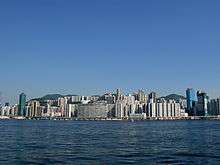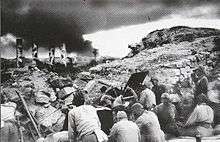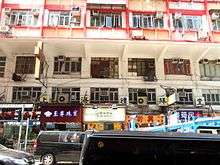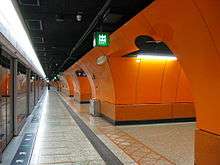North Point
Coordinates: 22°17′13.6″N 114°11′30″E / 22.287111°N 114.19167°E
| North Point | |||||||||||||||||||||||
 Skyline of North Point in 2008 | |||||||||||||||||||||||
| Chinese | 北角 | ||||||||||||||||||||||
|---|---|---|---|---|---|---|---|---|---|---|---|---|---|---|---|---|---|---|---|---|---|---|---|
| Cantonese Yale | bāk gok | ||||||||||||||||||||||
| |||||||||||||||||||||||
North Point (Chinese: 北角; Pe̍h-ōe-jī: Pak-kak) is a mixed-use urban area in the Eastern District of Hong Kong. It is in the northeastern part of Hong Kong Island, between Causeway Bay and Quarry Bay, and projects toward Kowloon Bay.[1]
Location
North Point is bounded by Hing Fat Street (興發街) to the west and by Mansion Street (民新街) to the east, by Victoria Harbour to the north and Braemar Hill to the south.[2] The Fortress Hill area forms the westernmost part of North Point, while the Tsat Tsz Mui area is located in its easternmost part.
History


Parts of North Point have been inhabited since before the British arrived in the mid-19th century. The Metropole Hotel was built in 1899 and was used until 1906.[3] In 1919, the Hongkong Electric Company started operation of the territory's second power station at North Point.[4] In the 1920s, Ming Yuen Amusement Park became a popular entertainment venues on the Island. During the 1930s, the beaches of North Point became one of the most popular places for holding swimming gala in Hong Kong. In 1938, the North Point Refugee Camp was built to accommodate the influx of refugees from the Mainland. The camp comprised 26 huts. Access to the camp was via Kam Hong Road and Marble Road. During World War II, the camp was renamed the North Point Camp, and used as a prisoner of war camp for captured Canadian soldiers during the Japanese occupation.[5]
During the Chinese Civil War, a large number of the rich and middle class from Shanghai fled to Hong Kong to escape the turmoil of war, many of them settled in North Point. In 1950, North Point became known as "Little Shanghai", since in the minds of many, it has already become the replacement for the surrendered Shanghai in China.[1] The first wave of emigrants introduced Shanghai-style restaurants, beauty parlours and barbershops. They also learned Cantonese and intermarried with people of other dialect groups. During the 1950s, North Point was the premiere place of residence for these emigrants, leading to a massive population boom; by the end of 1960, North Point was listed as the most densely populated place on earth by the Guinness Book of Records.[6] The first school in Hong Kong to use Mandarin as the main medium of instruction, Kiangsu and Chekiang Primary School, was founded in 1953 in North Point by these early Shanghainese immigrants. Shanghai at the time was heavily associated with leftist movements; leftist-supported businesses in North Point, such as the Sunbeam Theatre which showcases Chinese Opera, are a legacy of their influence.
The second group that moved to North Point were the Fujianese, who were mostly displaced by political events in Southeast Asia. Small Indonesian specialist grocery shops selling coffee, coconuts, and bumbu are some of the remaining traces of their identity. The area became known as "Little Fujian".[1]
Culture
After Cantonese, Min Nan is the most widely spoken language here. Many Min Nan associations (閩南同鄉會) are based in North Point to bring people from the same towns or villages together. Several Min Nan-speaking churches are located in North Point to serve the Min Nan Christians.[7]



Today North Point comprises a mix of new luxury developments and older Chinese buildings.

Housing
.jpg)
Two public housing estates are located in North Point: Model Housing Estate, the oldest existing public housing estate in Hong Kong,[8] with several blocks completed in 1954, and Healthy Village. City Garden, built from 1983 to 1986, is a private housing estate consisting of 14 blocks, each 28 storeys tall. Part of the site was occupied North Point Power Station before 1983.
North Point Estate, beside the North Point Ferry Pier, was demolished in 2003.
Education
There are three government primary schools in North Point. Located at 888 King's Road, the North Point Government Primary School (NPGPS) opened in 1954. The North Point Island Place Primary and Kindergarten School is located on Tanner Road and is in the Island Place Estate. The North Point Government Primary School (Cloud View Road) abbreviated as NPCVR, also opened in 1954, is located at 22 Cloud View Road. All three schools are whole-day, co-ed and have nominated secondary school status with Shau Kei Wan GSS, Shau Kei Wan East GSS and Clementi Secondary School.
Located near Tin Hau Station is Island Children's Montessori School & Kindergarten (ICMS, Chinese: 港島兒童蒙特梭利學校), an international school providing playgroup, nursery, kindergarten and summer camp programs.[9] Established in 2008, it was chosen as one of the top kindergartens in Hong Kong by Asia Tatler in 2011.[10]
The Hong Kong Japanese School's Secondary Section is on Braemar Hill in North Point.[11]
The Chinese International School is located on Hau Yuen Path in Braemar Hill and is a private, co-educational school providing education to students from Reception to Year 13. Established in 1983,[12] the school has a diverse student body with over 30 nationalities represented. Secondary school students pursue the IB Primary Years Programme before moving on to the IB Diploma.
Transport

North Point is served by the Island Line and the Tseung Kwan O Line of the MTR rapid transit railway system. North Point Station is the terminus of the Tseung Kwan O Line. There is one highway, Island Eastern Corridor, serving North Point; it runs along the waterfront of the area. North Point is also served by Hong Kong Tramways, of which it is one of the seven terminal points. Kowloon Motor Bus, New World First Bus and Citybus have routes through North Point. Hongkong and Yaumati Ferry services connect North Point Ferry Pier to various places in Hong Kong, including Hung Hom, Kowloon City, and Kwun Tong. During the annual Tin Hau Festival, special ferries operate from North Point Ferry Pier to Joss House Bay. North Point is also served by public light buses.
Streets in North Point include:
See also
References
- 1 2 3 Wordie, Jason (2002). Streets: Exploring Hong Kong Island. Hong Kong University Press. ISBN 962-209-563-1.
- ↑ Heritage Impact Assessment on the Former Clubhouse of Royal Hong Kong Yacht Club at 12 Oil Street Vol 1 Part 1, p.9
- ↑ http://gwulo.com/node/6577 Gwulo. The Metropole Hotel, North Point [1898-1906]. Retrieved 17 July 2012.
- ↑ "Electricity Generation". Hongkong Electric Holdings Limited. Retrieved 2009-01-02.
- ↑ http://gwulo.com/node/9853 Gwulo. North Point Refugee / POW camp. Retrieved 17 July 2012.
- ↑ Guinness Book of Records, 4th edition, November 1960, p.74.
- ↑ 黃彩蓮 (Kinia C. Ng) (2005). 香港閩南教會研究 (Research on Hong Kong Min-nam church) (in Chinese). Hong Kong: Alliance Bible Seminary.
- ↑ Aged public housing estates included in the Comprehensive Structural Investigation Programme
- ↑ Island Children's Montessori School - Program List Retrieved 2012-09-18.
- ↑ Top Kindergartens in Hong Kong Retrieved 2012-09-18.
- ↑ "About JIS" (Archive). Hong Kong Japanese School. Retrieved on 12 January 2015.
- ↑ http://www.cis.edu.hk/
External links
- History of North Point, in Heritage Impact Assessment on the Former Clubhouse of Royal Hong Kong Yacht Club at 12 Oil Street Vol 1 Part 1, pp. 9–70
- New World First Ferry
- Fortune Ferry
| Wikimedia Commons has media related to North Point. |

